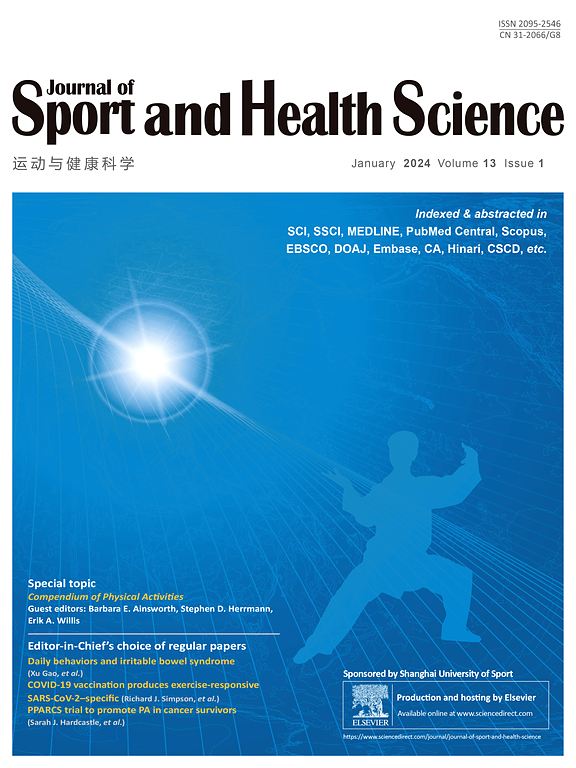军事训练环境中搏击活动中与脑震荡相关的因素。
IF 10.3
1区 医学
Q1 HOSPITALITY, LEISURE, SPORT & TOURISM
引用次数: 0
摘要
军事服役人员经常参加格斗训练(拳击、柔道、武术和徒手格斗),以获得和保持任务的基本技能。尽管采取了减轻伤害的策略,但据报道,在参加格斗运动时,每100次接触中发生20.8次脑震荡的脑震荡发生率很高。这项研究的目的是确定在军事训练环境中,这些战斗活动中可能与脑震荡发生几率增加有关的因素。方法采用回顾性队列研究方法,选取2014 - 2020年参加脑震荡评估、研究和教育联盟的4所军校的参与者。在入组时收集人口统计信息(地点、校队状态、运动接触水平、性别、脑震荡史和头痛史)和损伤前基线评估(如平衡误差评分系统(BESS)、简短症状量表(BSI))。使用单变量和多变量逻辑回归模型来估计在这些损伤前特征的基础上,在随访期间参加格斗训练时持续脑震荡的几率。结果在研究期间,17681名参与者(25%为女性,19.11±1.45岁(平均±SD))完成了基线评估,484名参与者(35%为女性,19.88±1.43岁)在格斗训练中遭受脑震荡。单因素logistic回归模型显示女性(比值比(OR) = 1.71;P < 0.001;95%置信区间(95% ci): 1.41-2.07),参加高接触性校队运动(OR = 0.52;P < 0.001;95%CI: 0.38-0.71), BSI总分(OR = 1.03;P < 0.001;95%CI: 1.01-1.04), BESS总分(OR = 1.02;P < 0.001;95%CI: 1.02-1.04),头痛史(OR = 1.43;P < 0.001;95%可信区间:1.18-1.73)与维持与战斗相关的脑震荡的更大几率相关。在控制了显著协变量后,多变量模型得出了类似的结果。结论:基线时BSI和BESS总分较高的女性,以及有头痛病史的参与者在随访期间发生与打斗有关的脑震荡的几率更大。相反,参加高接触的校队运动的参与者发生与打斗有关的脑震荡的几率较低。在军事环境中设计格斗训练计划时,应考虑到这些不同的变量。本文章由计算机程序翻译,如有差异,请以英文原文为准。
Factors associated with concussion during combatives activities in a military training environment.
BACKGROUND
Military service members routinely participate in combatives training (boxing, judo, martial arts, and hand-to-hand combat) to acquire and maintain mission essential skills. Despite injury mitigation strategies, high concussion incidence rates of 20.8 concussions per 100 exposures while participating in combative sports have been reported. The purpose of this study was to identify factors potentially associated with greater odds of sustaining a concussion in these combative activities in a military training environment.
METHODS
A retrospective cohort study was conducted with participants enrolled at 4 military service academies participating in the Concussion Assessment, Research, and Education Consortium from 2014 to 2020. Demographic information (site, varsity status, sport contact level, sex, concussion history, and headache history) and pre-injury baseline assessments (e.g., Balance Error Scoring System (BESS), Brief Symptom Inventory (BSI)) were collected at the time of enrollment. Univariate and multivariable logistic regression models were used to estimate the odds of sustaining a concussion while participating in combatives training during the follow-up period based on these pre-injury characteristics.
RESULTS
During the study period, 17,681 participants (25% female;19.11 ± 1.45 years (mean ± SD) completed a baseline assessment and 484 (35% female;19.88 ± 1.43 years) sustained a concussion during a combatives training. Univariate logistic regression models revealed females (odds ratio (OR) = 1.71; p < 0.001; 95% confidence interval (95%CI): 1.41-2.07), participating in high contact varsity sports (OR = 0.52; p < 0.001; 95%CI: 0.38-0.71), BSI total score (OR = 1.03; p < 0.001; 95%CI: 1.01-1.04), BESS total score (OR = 1.02; p < 0.001; 95%CI: 1.02-1.04), and headache history (OR = 1.43; p < 0.001; 95%CI: 1.18-1.73) were associated with greater odds of sustaining a combatives-related concussion. Multivariable models yielded similar results after controlling for significant covariates.
CONCLUSION
Females, higher BSI and BESS total scores at baseline, and participants with a history of headaches had greater odds of sustaining a combatives-related concussion during the follow-up period. Conversely, participants in high contact varsity sports had lower odds of sustaining a combatives-related concussion. These different variables should be taken into account when designing combatives training programs in a military setting.
求助全文
通过发布文献求助,成功后即可免费获取论文全文。
去求助
来源期刊

Journal of Sport and Health Science
SPORT SCIENCES-
CiteScore
18.30
自引率
1.70%
发文量
101
审稿时长
22 weeks
期刊介绍:
The Journal of Sport and Health Science (JSHS) is an international, multidisciplinary journal that aims to advance the fields of sport, exercise, physical activity, and health sciences. Published by Elsevier B.V. on behalf of Shanghai University of Sport, JSHS is dedicated to promoting original and impactful research, as well as topical reviews, editorials, opinions, and commentary papers.
With a focus on physical and mental health, injury and disease prevention, traditional Chinese exercise, and human performance, JSHS offers a platform for scholars and researchers to share their findings and contribute to the advancement of these fields. Our journal is peer-reviewed, ensuring that all published works meet the highest academic standards.
Supported by a carefully selected international editorial board, JSHS upholds impeccable integrity and provides an efficient publication platform. We invite submissions from scholars and researchers worldwide, and we are committed to disseminating insightful and influential research in the field of sport and health science.
 求助内容:
求助内容: 应助结果提醒方式:
应助结果提醒方式:


